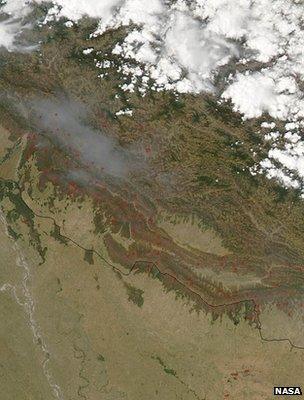Nepal forest fires 'cause big wildlife loss'
- Published

Nepalese officials are piloting a satellite system to monitor the location of the fires
Protected areas in Nepal and northern India have been affected by forest fires, with at least one suffering huge wildlife losses, officials have said.
They say nearly 70% of Nepal's Bardiya National Park has been consumed by fire in the past few days.
The park had been deemed a success story for elephant conservation, as well as being a refuge for endangered species such as tigers and rhinos.
Officials said a lack of resources allowed the fires to spread rapidly.
"We have not been able to assess the loss immediately because the fire is still raging at some places," the park's chief conservation officer Tika Ram Adhikari told BBC News.
"But given our past experiences, our estimate is that around 40% of small mammals, 60% of insects and significant number of birds have been lost in the fire."
Mr Adhikari said big animals such as elephants and tigers might have been able to escape.
"But we fear, at places, their babies might have died after getting trapped in the fire."
<bold>'Crown fires'</bold>
Other protected areas, including the Chitwan National Park and Parsa Wildlife Reserve, were among the 225 forest fire sites that have been recorded in Nepal.

Some of the region's larger animals, such as rhinos, are feared to have perished in the fires
Although officials said there was no widespread damage in most places, the Bardiya National Park witnessed an unusual intensity of fire that engulfed the tops of trees.
"We call it 'crown fire' and it is quite devastating because it finishes the entire tree and spreads around quite dangerously," explained Mr Adhikari.
Although Nepalese officials said the fire at the national park had spread to forests in bordering India including the Dudhuwa national park, Indian officials said the situation was under control.
"We did spot fire at two locations in the Dudhuwa National Park but we managed to put them out," said park director Shailesh Prasad.
Another protected area in northern India adjoining Nepal's Chitwan National Park, the Valmiki Tiger Reserve experienced some fire as well.
"But it was on grassland and we could bring it under control before it could spread to the forest land," said the reserve's director Santosh Tiwari.
Indian officials say they are quite prepared to deal with the events of fires in protected areas.
"We have a rapid action team that does the job quite efficiently," said Mr Prasad.
"We have tankers and tractors on standby even in the nights; they are mobilised as and when required."
<bold>Lack of capacity</bold>
In Nepal, however, lack of preparedness and resources meant that wildfire spread quite quickly, mainly in the forests and protected areas across the plains bordering India, officials said.
"We do not have the capacity, resource and equipment to fight fires of this scale," said Krishna Acharya, director-general of Nepal's department of national parks and wildlife conservation.
"How long can we fight the fire with just soil and brooms made up of plants?" he told BBC News.
"That is why despite our efforts to contain it, the forest fire has continued in these different areas."
Mr Acharya said fire-fighting in national parks and forested areas in mountainous regions of northern Nepal had been even more challenging.
"Most of these places are unpopulated and reaching such locations is quite difficult," he said.
Conservationists say forests in mountain regions are particularly vulnerable because the dominant tree species are conifers, whose resins make them highly flammable.
A recent fire had threatened to spread across into neighbouring Tibet, but heavy snowfall in the region prevented it from spreading further.
Police officials said that officers and soldiers needed to be specifically trained to fight wildfires.
In 2009, more than one dozen soldiers lost their lives while trying to contain fire in a mountain region.
"The soldiers back then did not even know that you do not fight fire from the upper side of the mountain," a senior police official said.
Experts say community forest user groups also need to be trained.
"Since there is no preparedness to fight forest fire, you will have addressed significant portion of the problem by training members of community forests' user groups," said Sundar Sharma, co-ordinator of the Regional South Asia Wildland Fire Network.
"If each community forest user group has trained fire fighters, in most cases they can contain the fire. But if it is a real big disaster, then there will have to be a bigger operation from the centre."
- Published26 April 2012